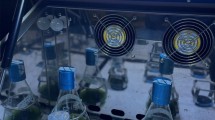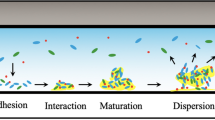Abstract
The uptake kinetics of leucine and the assimilation and respiration of leucine, glycine, glutamate and arginine by a marinePseudomonas sp. was evaluated to determine whether the uptake and efficiency of substrate utilization of free-living bacteria differed from that of bacteria associated with surfaces. Bacteria were allowed to attach to plastic substrata with known hydrophilicities, as measured by advancing water contact angle (θ A); these were Thermanox, poly(vinylidene fluoride), poly(ethelene) and poly(tetrafluoroethylene). The assimilation and respiration of surface-associated bacteria depended on the amino acid and substratumθ A, but assimilation by surface-associated cells was generally greater than and respiration was generally less than that by free-living bacteria. The uptake kinetics with leucine demonstrated that the half saturation constant (K) of surface-associated bacteria was greater than that for free-living cells. The Vmax values for surface-associated and free-living bacteria were similar, except for cells associated with poly(tetrafluoroethylene), which had a higher Vmax value.
Similar content being viewed by others
References
Azam F, Hodson RE (1977) Size distribution and activity of marine microheterotrophs. Limnol Oceanogr 22:492–501
Bent EJ, Goulder R (1981) Planktonic bacteria in the Humber Estuary: Seasonal variation in population density and heterotrophic activity. Mar Biol 62:35–42
Bransome ED, Grower MF (1970) Liquid scintillation counting of (3H) and (14C) on solid supports. Anal Biochem 38:401–408
Bright JJ, Fletcher M (1983) Amino acid assimilation and electron transport system activity in attached and free-living marine bacteria. Appl Environ Microbiol 45:818–825
Corpe WA (1973) Microfouling: The role of primary film-forming bacteria. In: Acker RF, Brown BF, DePalma JR, Inverson WP (eds) Proc 3rd Intn Congr Mar Corrosion and Fouling, Northwestern University Press, Evanston, Ill, pp 598–609
Eastermann EF, McLaren AD (1959) Stimulation of bacterial proteolysis by adsorbents. J Soil Sci 10:64–78
Ellwood DC, Keevil CW, Marsh PD, Brown CM, Wardell JN (1982) Surface-associated growth. Phil Trans R Soc Lond B 297:517–532
Fletcher M (1979) A microautoradiographic study of the activity of attached and free-living bacteria. Arch Microbiol 122:271–274
Fletcher M (1979) The attachment of bacteria to surfaces in aquatic environments. In: Ellwood DC, Melling J, Rutter PR (eds) Adhesion of microorganisms to surfaces. Academic Press, London, pp 87–108
Fletcher M (1980) The question of passive versus active attachment mechanisms in non-specific bacterial adhesion. In: Berkeley RCW, Lynch JM, Melling J, Rutter PR, Vincent B (eds) Microbial adhesion to surfaces. Ellis Horwood Publishers, Chichester, England, pp 197–210
Fletcher M, Floodgate GD (1973) An electron-microscopic demonstration of an acidic polysaccharide involved in adhesion of a marine bacterium to solid surfaces. J Gen Microbiol 74:325–334
Fletcher M, Loeb GI (1979) The influence of substratum characteristics on the attachment of a marine pseudomonad to solid surfaces. Appl Environ Microbiol 37:67–72
Fletcher M, Marshall KC (1982) Bubble contact angle method for evaluating substratum interfacial characteristics and its relevance to bacterial attachment. Appl Environ Microbiol 44:184–192
Geesey GG (1982) Microbial exopolymers: ecological and economic considerations. Am Soc Microbiol News 48:9–14
Goldman R, Goldstein L, Kalchalski E (1971) Water-soluble enzyme derivatives and artificial enzyme membranes. In: Stark GR (ed) Biochemical aspects of reactions on solid supports. Academic Press, New York, pp 1–78
Goulder R (1977) Attached and free bacteria in an estuary with abundant suspended solids. J Appl Bacteriol 43:399–405
Hanson WJ, Wiebe WJ (1977) Heterotrophic activity associated with paniculate size fractions in aSpartina altermiflora salt-marsh estuary, Sapels Island, Georgia, USA and the Continental Shelf Waters. Mar Biol 42:321–330
Harwood JH, Pirt SJ (1972) Quantitative aspect of growth of the methane oxidizing bacteriumMethylococcus capsulatus in shake flask and continuous chemostat culture. J Appl Bacteriol 35:597–607
Hattori R, Hattori T (1963) Effect of the solid liquid interface on the life of microorganisms. Ecol Rev 16:63–70
Hattori R, Hattori T (1981) Growth rate and molar growth yield ofEscherichia coli adsorbed on an anion-exchange resin. J Gen Appl Microbiol 27:287–298
Hattori T, Hattori R (1976) The physical environment in soil microbiology: An attempt to extend principles of microbiology to soil microorganisms. CRC Crit Rev Microbiol 4:423–461
Helfferich F (1962) Ion Exchange. McGraw-Hill, New York
Heukelekian H, Heller A (1940) Relation between food concentration and surface for bacterial growth. J Bacteriol 40:547–558
Horrocks DL (1977) The H number concept. Technical Report 1095 NUC 77-1T. Scientific Instruments Division, Beckman Instruments Inc
Jannasch HW, Pritchard PH (1977) The role of inert particulate matter in the activity of aquatic microorganisms. Mem Ist Ital Idrobiol Suppl 29:289–308
Kester DR, Duedall IW, Conners DN, Pythowicz RN (1967) Preparation of artificial seawater. Limnol Oceanogr 12:176–179
Kirchman D, Mitchell R (1982) Contribution of particle-bound bacteria to total microheterotrophic activity in five ponds and two marshes. Appl Environ Microbiol 43:200–209
Kriss AE (1963) Marine microbiology (deepsea). Oliver and Boyd, Edinburgh and London
Marshall KC (1976) Interfaces in microbial ecology. Harvard University Press, Cambridge, Massachusetts
McLaren AD, Skujins J (1963) Nitrification ofNitrobacter agilis on surfaces and in soil with respect to hydrogen ion concentration. Can J Microbiol 9:729–731
Navarro JM, Durand G (1977) Modification of yeast metabolism by immobilization onto porous glass. Eur J Appl Microbiol 4:243–254
Paerl HW (1975) Microbial attachment to particles in marine and freshwater ecosystems. Microb Ecol 2:73–83
Pringle JH, Fletcher M (1983) Influence of substratum wettability on the attachment of fresh-water bacteria to solid surfaces. Appl Environ Microbiol 45:811–817
Riley GA (1970) Particulate organic matter in the sea. Adv Mar Biol 8:1–118
Stotzky G (1972) Activity, ecology and population dynamics of microorganisms in soil. CRC Crit Rev Microbiol 2:59–137
Stotzky G (1980) Surface interactions of microorganisms, viruses and organics with clay minerals and the probable importance of these interactions in microbial ecology and in migration of clay organic complexes. Coll Intr CNRS No. 303:173–181
Williams PJ LeB (1970) Heterotrophic utilization of dissolved organic compounds in the sea. I. Size distribution of population and relationship between respiration and incorporation of growth substrates. J Mar Biol Ass UK 50:859–870
Wright RT, Hobbie JE (1966) The use of glucose and acetate by bacteria and algae in aquatic ecosystems. Ecology 47:447–464
ZoBell CE (1977) Substratum: bacteria, fungi and blue-green algae. In: Keine O (ed) Marine Ecology, Vol. I Wiley InterScience, London, pp 1251–1270
Zvyagintsev DG (1973) Interaction between microorganisms and solid surfaces. Moscow University Press, Moscow
Author information
Authors and Affiliations
Rights and permissions
About this article
Cite this article
Bright, J.J., Fletcher, M. Amino acid assimilation and respiration by attached and free-living populations of a marinePseudomonas sp.. Microb Ecol 9, 215–226 (1983). https://doi.org/10.1007/BF02097738
Issue Date:
DOI: https://doi.org/10.1007/BF02097738




